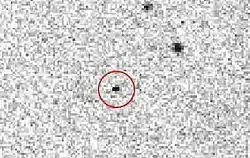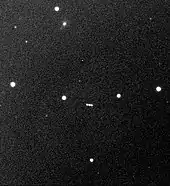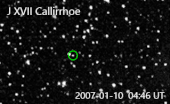Callirrhoe (moon)
Callirrhoe (/kəˈlɪroʊ.iː/; Greek: Καλλιρρόη), also known as Jupiter XVII, is one of Jupiter's outer natural satellites. It is an irregular moon that orbits in a retrograde direction. Callirrhoe was imaged by Spacewatch at Kitt Peak National Observatory from October 6 through November 4, 1999,[8] and originally designated as asteroid 1999 UX18.[9][10] It was discovered to be in orbit around Jupiter by Tim Spahr on July 18, 2000, and then given the designation S/1999 J 1.[1][11] It was the 17th confirmed moon of Jupiter.[8]
 Discovery image of Callirrhoe taken by Spacewatch in October 1999 | |
| Discovery [1] | |
|---|---|
| Discovered by | Spacewatch[lower-alpha 1] |
| Discovery site | Kitt Peak National Observatory |
| Discovery date | 19 October 1999 |
| Designations | |
Designation | Jupiter XVII |
| Pronunciation | /kəˈlɪroʊiː/[3][4] |
Named after | Καλλιρρόη Kallirrhoê |
| S/1999 J 1 1999 UX18 | |
| Orbital characteristics [5] | |
| Epoch 27 April 2019 (JD 2458600.5) | |
| Observation arc | 17.54 yr (6,406 days) |
| 0.1643278 AU (24,583,090 km) | |
| Eccentricity | 0.3095704 |
| –787.43 d | |
| 240.90203° | |
| 0° 27m 25.866s / day | |
| Inclination | 147.99790° (to ecliptic) |
| 352.75480° | |
| 68.21981° | |
| Satellite of | Jupiter |
| Group | Pasiphae group |
| Physical characteristics | |
Mean diameter | 9.6±1.3 km[6] |
| Albedo | 0.052±0.016[6] |
| 20.8[7] | |
| 13.9[5] | |
Name

It was named in October 2002 after Callirrhoe, daughter of the river god Achelous, one of Zeus' (Jupiter's) many conquests.[12]
Characteristics
Callirrhoe has an apparent magnitude of 20.7,[13] making it even fainter than dwarf planet Eris at magnitude 18.7.[14] Jupiter is about 2.5 billion times brighter than Callirrhoe.[15]
Callirrhoe is about 9.6 kilometers in diameter,[6] and orbits Jupiter at an average distance of 24.1 million kilometers in 758 days, at an inclination of 141° to the ecliptic (140° to Jupiter's equator) with an eccentricity of 0.28. This object was probably captured long ago from a heliocentric orbit and the Sun's gravitational influence makes this orbit highly erratic.[8]
It belongs to the Pasiphae group, irregular retrograde moons orbiting Jupiter at distances ranging between 22.8 and 24.1 million kilometers, and with inclinations ranging between 144.5° and 158.3°.
Exploration

As a navigation exercise, the New Horizons spacecraft imaged Callirrhoe on January 10, 2007.[16]
Notes
- The discovery is credited to the team of astronomers consisting of J. V. Scotti, T. B. Spahr, R. S. McMillan, J. A. Larson, J. Montani, A. E. Gleason, and T. Gehrels.[2]
References
- Brian G. Marsden (20 July 2000). "IAUC 7460: S/1999 J 1". IAU. Archived from the original on 26 April 2006. Retrieved 22 November 2005.
- "Planet and Satellite Names and Discoverers". Gazetteer of Planetary Nomenclature. USGS Astrogeology Science Center. Retrieved 26 November 2020.
- Noah Webster (1884) A Practical Dictionary of the English Language
- "Pasiphae". Dictionary.com Unabridged. Random House.
- "M.P.C. 115890" (PDF). Minor Planet Circular. Minor Planet Center. 27 August 2019.
- Grav, T.; Bauer, J. M.; Mainzer, A. K.; Masiero, J. R.; Nugent, C. R.; Cutri, R. M.; et al. (August 2015). "NEOWISE: Observations of the Irregular Satellites of Jupiter and Saturn" (PDF). The Astrophysical Journal. 809 (1): 9. Bibcode:2015ApJ...809....3G. doi:10.1088/0004-637X/809/1/3. S2CID 5834661. 3.
- Sheppard, Scott. "Scott S. Sheppard - Jupiter Moons". Department of Terrestrial Magnetism. Carnegie Institution for Science. Retrieved 26 November 2020.
- "New Outer Satellite of Jupiter Discovered". Minor Planet Center. Retrieved 23 July 2009.
- "New moon of Jupiter found". SpaceFlight Now (University of Arizona News Release). Retrieved 23 July 2009.
- MPS 7418 (Minor Planet Circulars Supplement); not available on-line
- MPEC 2000-Y16: S/1975 J 1 = S/2000 J 1, S/1999 J 1 2000-12-19 (discovery and ephemeris)
- IAUC 7998: Satellites of Jupiter 2002 October 22 (naming the moon)
- "Planetary Satellite Physical Parameters". JPL (Solar System Dynamics). 3 April 2009. Retrieved 23 July 2009.
- "AstDys (136199) Eris Ephemerides". Department of Mathematics, University of Pisa, Italy. Retrieved 16 March 2009.
- (5th root of 100)^(20.7-(-2.8))=2.51 billion
- "New Horizons Jupiter Encounter Timeline". www.planetary.org.